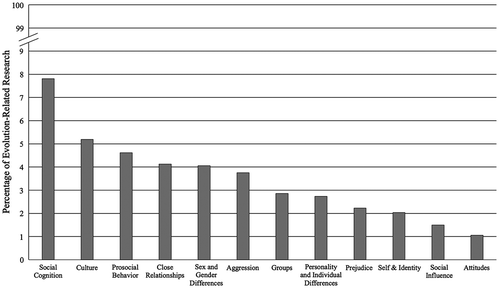Evolutionary theory has revolutionized our understanding of the physical world. With the advent of such journals as Evolutionary Behavioral Sciences and Evolutionary Psychology, evolutionary frameworks have been flourishing within Psychology to provide novel ways of thinking about human behavior and functioning. That influx, however, is more prevalent in some areas than others. Consider the subfields of Social Psychology, which is home to most members of the International Society for Self and Identity. As displays, the percentage of publications in each subfield that involve evolution from the present back to 1900—two years after the publication of what is arguably the first social psychological experiment, i.e., Triplett (Citation1898), and forty-one years after the publication of Darwin’s Origin of Species (Citation1859)—varies considerably and the study of self and identity is among the least to involve evolution.
Figure 1. The percentage of publications from 1900 to present in each subfield of social psychology that involves evolution.
Notes: To estimate the percentages, we searched PsychInfo using terms for each subfield (limited to the “keywords” search-field) both with and without the phrase “evol*” (not limited to any search field). We used the following phrases as terms for each subfield (ordered as they appear in the figure): “social cognition*”; “culture*”; “altruis* or help* or prosocial* or empath*”; “attract* or mate* or relationship* or marital* or marriage*”; “sex difference* or gender difference*; “aggress*”; “group* not thera* (excludes publications related to group therapy); “personality* or trait* or individual difference* not disorder* (excludes publications related to the diagnosis of clinical personality disorders); “identity* or self* not self-report*” (excludes “self-report” as it refers to methodology rather than research area); “conform* or comply* or complian* or obedien*”; and “attitude*”.

Hence, our goal for this special issue is to (re)introduce readers of Self and Identity to the potential conceptual and empirical insights offered by an evolutionary framework. To that end, this special issue on Evolution and the Self includes five articles that approach different issues of self and identity from an evolutionary perspective. Skowronski and Sedikides (Citation2019) revisit and update after 20 years of additional data their original proposition that the human capacity for a self is a product of evolution (Sedikides & Skrownski, Citation1997). Young, Simpson, Griskevicious, Huelsnitz, and Fleck (Citation2019) use evolutionary life-history theory (e.g., Kaplan & Gangestad, Citation2005; Stearns, Citation1992) to predict and explain why childhood attachment in the first year-and-a-half of life prospectively forecasts two clusters of Big 5 personality traits at age 32. Beall and Schaller (Citation2019) also draw from life-history theory to demonstrate that two motivational aspects of the self-system, acquiring mates and providing parental-care, have inverse manifestations. Reynolds and McCrea (Citation2019) use an evolutionary framework to question the assumption that self-control is invariantly advantageous and demonstrate that its functionality is context-dependent. Dean, Wentworth, and LeCompte (Citation2019) use an evolutionary approach to examine how social vulnerability promotes experiences of physical vulnerability and tests whether threats to belonging evoke perceived threats to physical safety.
We extend a sincere “thank you” to the contributing authors for demonstrating how adopting an evolutionary framework in the study of self and identity can promote conceptual insights and empirical advances. We hope readers of Self and Identity find this special issue to be valuable for forwarding their own research endeavors and that research at the intersection of the self and evolutionary science continues to thrive.
Erin M. O’Mara
Lowell Gaertner
Guest Editors
Disclosure statement
No potential conflict of interest was reported by the authors.
References
- Beall, A., & Schaller, M. (2019). Evolution, motivation, and the mating / parenting trade off. Self and Identity Special Issue: Evolution and the Self.
- Darwin, C. (1859). On the origin of the species by means of natural selection, or the preservation of favoured races in the struggle for life. London: Murray.
- Dean, K., Wentworth, G., & LeCompte, N. (2019). Social exclusion and perceived vulnerability to physical harm. Self and Identity Special Issue: Evolution and the Self.
- Kaplan, H. S., & Gangestad, S. W. (2005). Life history theory and evolutionary psychology. In D. M. Buss (Ed.), Handbook of evolutionary psychology (pp. 68–95). New York, NY: Wiley.
- Reynolds, J., & McCrea, S. (2019). Environmental constraints on the functionality of inhibitory self-control: Sometimes you should eat the donut. Self and Identity Special Issue: Evolution and the Self.
- Sedikides, C., & Skowronski, J. J. (1997). The symbolic self in evolutionary context. Personality and Social Psychology Review, 1, 80–102.
- Skowronski, J. J., & Sedikides, C. (2019). On the Evolution of the Human Self: A Data-Driven Review and Reconsideration. Self and Identity Special Issue: Evolution and the Self.
- Stearns, S. (1992). The evolution of life histories. Oxford, England: Oxford University Press.
- Triplett, N. (1898). The dynamogenic factors in pacemaking and competition. The American Journal of Psychology, 9, 507–533.
- Young, E., Simpson, J., Griskevicius, V., Huelsnitz, C., & Fleck, C. (2019). Childhood attachment and adult personality: A life history perspective. Self and Identity Special Issue: Evolution and the Self.
